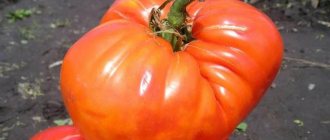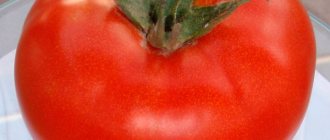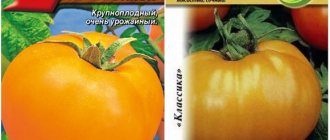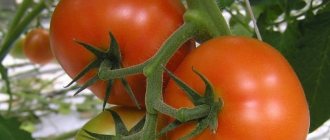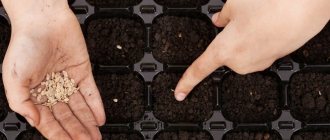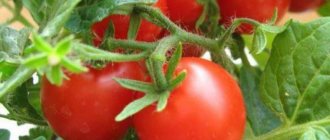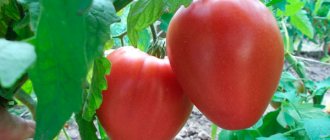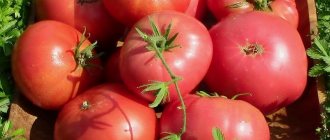The Azure giant tomato has many interesting names. It is also called Sugar or Radiant for its excellent taste and unusual color.
| Height | Landing location | Ripening time | Fruit color | Fruit size | Origin | Fruit shape |
| Medium height | Greenhouse, Open ground | Mid-season | Purple | Large | Variety | Flat-round |
Brief information about the variety
- Fruits and bush : purple tomatoes (in whole or in places), flat-round in shape, weight - from 150 to 500 g; determinate bush, 80-130 cm high.
- Productivity : unstable, can be medium or high (from 4 to 10 kg per bush).
- Resistance : high to major diseases.
- Distribution : recommended for greenhouse cultivation in the regions of central Russia; in the south it can be cultivated in open ground.
- Application : salads, slices, assorted vegetables, freezing, processing (juices, ketchups, pastes).
- Planting : seedling method; sowing - in mid or late March; transplanting into a greenhouse - at the beginning or middle of May, into open ground - at the end of May; diagram – 50×70 cm.
- Soil : light, fertilized with humus.
- Care : watering - once every 8-10 days, fertilizing - every 2-3 weeks, formation - 1-2 stems, tying stems and fruit clusters - mandatory.
- Ripening period : mid-season - fruits are harvested 110-115 days after emergence. Storage – 1-1.5 months.
Tomato Azure giant F1: variety description, reviews, yield
General description and characteristics
Giant tomatoes are great for growing in gardens and greenhouses. Among the giant tomatoes there are both early-ripening and mid-ripening varieties. The height of an adult plant varies from 1.5 to 2.5 meters, there are determinate and indeterminate species.
The earliest varieties ripen on 80 - 100 days after planting (Early Giant F1, Sugar Giant, Giant Sukhanov), mid-ripening varieties ripen en masse on 110 - 125 days (Giant Cuba black tomatoes, Pear tomato, Giant Sweater, Giant of Belgium and Ukraine). On one plant, 5 - 6 clusters are formed, the weight of the fruit is 200 - 600 g. On some varieties, the fruits can grow up to 1 kg or a little more (Gigantissimo, Gigantistika, Giant Black Sea, Belgian).
Description of the variety, structural features of the crop
Azure giant F1 is a hybrid variety of tomato for growing in garden plots. In 2014, it was released onto the market by the Russian Vegetable Garden company from the Moscow region. Agricultural technology allows planting in most regions of the Russian Federation. In Siberia, the Urals, the Far East and other cool regions, it is recommended to grow the hybrid in a greenhouse. The tomato is not listed in the State Breeding Register.
In the annotation for the seeds on the website of the originating company, the tomato is called indeterminate, up to 2 m high. In practice, the bush turns out to be lower. Tomato growers advise to trim the crop at a certain stage of the growing season. In this case, it will be possible to harvest the crop from the shoots.
According to ripening time
By type of growth
By type of use
By growing method
Fruit weight (g)
Productivity (kg/m2)
Fetal characteristics
Useful tips
Before planting in open ground, seedlings should be hardened off: in the daytime, taken out into fresh air or into a cool room; from mid-April, they can be left overnight in a cold room.
Do not remove the top of the bush - this leads to the completion of fruit growth and their active ripening, to the detriment of size and yield. The crop grows in two stems - for this a strong stepson is left, all other shoots should not exceed half a centimeter.
Giant tomatoes do not like being next to potatoes, and the risk of late blight increases. It is necessary to carry out additional pollination of flowers during periods of calm and when the bushes are covered with bags. In hot weather, plants are shaded.
Features of agricultural technology of an extraordinary hybrid, reviews from gardeners
The only rational method of planting Early Giant F1 is seedlings. With proper care and good lighting, it develops quickly. The age of sprouts for moving to a permanent place is 45-55 days. Therefore, it is best to sow seeds in the second half of March.
Advice. The optimal layout is 60x70 cm. Place no more than 3 plants on one square of land area.
Additional tips for caring for tomatoes:
- the stepsons on the stems grow inactively, but still need periodic removal;
- grow a bush with 2 stems;
- water the garden bed at the rate of 6 liters per week per bush (divide into 2-3 portions).
The variety is very young, so there are few reviews about it. Gardeners had only 1 season to test tomatoes. According to information on Internet forums for summer residents, from 1 sq. m you can collect more than what was declared by the originator. Gardeners call volumes 19-20 kg per 1 sq. m. Otherwise the characteristics are the same.
Valeria from Odessa confirms in her review: the tomatoes are really huge. Culture did not take up much of her time and attention and withstood the vagaries of the weather. The fruits are good for sale. But they didn’t fit into canning jars.
The hybrid has a wide range of positive qualities. He will delight you with an early and abundant harvest. But so far the tomato has not been widely tested.
Tomato seedlings are planted in the ground. Sowing is carried out throughout March. By the beginning of May, young greenery will be ready to be transplanted into a greenhouse or hotbed, and at the beginning of June - into the garden. The plant bears fruit for about 2 months, starting in mid-July. Planting pattern on the site: 50×70 cm. Per 1 sq. m place 3 bushes.
- The best productivity of a tomato is achieved when formed into 1-2 stems;
- Start pinching the plant after tying 3-4 tassels;
- Place a support on the bed, start gartering from the 2nd week of life.
Not all gardeners are satisfied with growing this hybrid. People have trouble getting pure purple tomato skin. Natalya from Ulyanovsk region. showed a photo of her ripe harvest. There is blueness on it only at the stalk. She also did not like the mediocre yield of the crop - 4 tomatoes per bush.
Characteristics of the variety
In terms of ripening time, the hybrid is classified as mid-ripening (fruits ripen 110-115 days after the formation of seedlings).
Description of fruits and bush
The color of the skin of the fruit is purple (in whole or in places). The flesh is red, juicy, but quite dense. The shape of the fruit is flat-round, weight - from 150 to 500-600 g. The taste is sweet with sourness, rich.
Bushes of determinate or semi-determinate type, reach a height of 80-130 cm. The branching is intense, the foliage is average.
Application area
The main purpose of the fruit is fresh salads, slices, and sandwiches. Only the smallest tomatoes can be preserved whole; large ones are suitable for marinating in pieces in assorted vegetables. In addition, the fruits are used for stewed and baked dishes, and they are also used to make juices and ketchups.
Productivity
Azure giant F1 can produce high yields, but only with good care and favorable conditions. In such cases, at least 8-10 kg of fruits are collected from one bush. However, according to the descriptions of vegetable growers, the yield of this variety is unstable: in an unfavorable season it can drop to 3-4 kg per bush.
Resistance to diseases and pests
Like many hybrids, Azure Giant F1 is highly resistant to major nightshade diseases. However, preventive measures when growing it are mandatory. Large and sweet fruits often attract pests (aphids, whiteflies, slugs, spider mites).
():
Insect pests are not at all interested in the size and taste of tomato fruits. They feed on the juice of vegetative organs - leaves, stems.
Growing regions
First of all, the hybrid is recommended for greenhouse cultivation in regions with a temperate climate: Central Black Earth (Belgorod, Voronezh, Kursk, Tambov, Lipetsk regions), Central (Moscow, Vladimir, Tula, etc.), in the north-west of the country (Leningrad, Pskov, Novgorod regions).
In the Volga region, Krasnodar region and other southern regions, tomatoes can be grown in open ground. The Urals and northern regions of Russia require heated greenhouses.
Description of the hybrid tomato Azure giant f1, reviews and features
The hybrid tomato Azure Giant f1 receives consistently commendable reviews. This variety was created by Russian scientists specifically for cultivation in greenhouse conditions. In the warm climate that prevails in southern latitudes, tomatoes can also be planted in open ground. However, in this case, the manufacturer does not guarantee that the fruits will have the characteristics indicated on the packaging. With proper care and watering, the plant will delight farmers with exotic fruits of unusual color and impressive size.
General characteristics of tomato
The variety is early, determinate, and belongs to the dark-fruited category. Despite the name, the mature plant is not at all gigantic. Its height is no more than 100 cm. The trunk and branches are light green in color, the foliage density is average. Clusters are formed more often on the lower branches, closer to the top of the bush they become rarer, and the fruits are smaller. The stem and branches need to be tied up so as not to break or fall to the ground under the weight of the tomatoes.
- Ripe tomatoes have an interesting purple-chocolate color.
- Their skin is dense and strong.
- A ripe tomato can weigh up to 750 g.
- This is one of the most productive varieties developed through selective breeding. Up to 10 kg of tasty and juicy fruits of a round and slightly flattened shape are collected from the bush.
- Tomatoes are resistant to transportation and storage.
Users note the high taste of tomatoes. The pulp is dense and juicy, dark in color. Since the fruits are large in size and have an exquisite taste, they are eaten raw. Tomatoes are used for salads and slices, and they are used to make juice, ketchup and gravy. In its entirety, the Azure Giant serves as an excellent and original decoration for any table. Small berries can be frozen and rolled into jars. They retain their shape after boiling and thawing.
The advantages of the crop include high yield and excellent shelf life. The unique appearance of ripened fruits and their rich taste are noted. The plant is resistant to various diseases and can be stored for several months in the dark and cool. As for the disadvantages, it has been noted that tomatoes require special conditions. Deviation from the norm entails a change in the color of the fruit and a decrease in their weight.
Advantages and disadvantages
Plants need to be well looked after
The positive characteristics of the Azure Giant F1 tomato include:
- original fruit color;
- good tomato taste;
- large fruit;
- resistance to diseases.
Disadvantages of the variety:
- unstable yield;
- whimsicality in care.
Growing seedlings
To plant seedlings in a greenhouse in the first half of May, sowing is done in mid-March (taking into account the climate of the region and weather conditions). The seeds are treated with a solution of potassium permanganate and a growth stimulator, and germinated for 2-3 days in a warm place in a damp cloth. The soil is made from garden soil and purchased seedling mixture, combining them in equal proportions.
The seeds are deepened into the grooves by 0.5-1 cm, moistened with warm water and covered with polyethylene. Crops are kept at a temperature of 24-26 ° C until the first shoots appear.
When shoots appear, the temperature should be reduced to 16 °C and left at this level for 5-7 days (for better root development). Then it is raised again to 20-23 °C.
Water the tomatoes every 10 days using warm, settled water.
():
In small cassette cells or cups, the soil dries out very quickly, especially if the seedlings are standing in a well-lit window. In such cases, you have to water daily.
After the formation of 2 true leaves, the seedlings are moved to separate pots or a larger box. 2 weeks before planting in the greenhouse, the tomatoes are hardened: on fine days they are taken outside, gradually increasing the time spent in such conditions.
Rules of agricultural technology
The description of the Azure and Early Giant tomato varieties confirms that tomatoes require a lot of attention from gardeners and some care.
To protect tomatoes from diseases, it is necessary to observe crop rotation and not plant tomatoes in the same place for several years in a row.
Seed treatment
Before planting, seeds purchased from a specialized store or obtained from the harvest are treated with a weak solution of potassium permanganate. They are then washed in clean water and placed in a special solution that stimulates growth. After 1 day of exposure to the drug, the seeds are placed in a cool room for hardening.
This variety is grown by planting seedlings. To plant seeds, obtain light soil consisting of humus and garden soil. River sand and wood ash, calcined in the oven, are also added to this mixture.
Planting seeds
Plant the seeds at the end of winter in containers with soil. The seeds are buried in small grooves and sprinkled with peat on top. Then the container is watered with warm, settled water. The air temperature in the room should be about +23 - 25 degrees. After the first shoots appear, the containers are taken to a room with a lower temperature, +16 - 20 degrees. There should be no drafts.
They are placed on the sunny side, providing sufficient illumination. If the weather is cloudy for a long time, it is advisable to provide additional lighting with fluorescent lamps. Containers with seeds should be watered carefully, using a spray bottle or a regular strainer.
After the formation of the first leaf, the seedlings are picked, transplanted into another container and watered with complex fertilizers. For hardening, seedlings, starting from the end of April, are taken out into a cooler room or into the air every day.
Transplanting seedlings into soil
Transplantation into the soil is carried out towards the end of May. Bushes of these varieties are placed in such a way that per 1 sq. m accounted for 3 plants. Fertilizers and wood ash are added to the dug hole, and then the seedling is placed and covered with soil. Bushes with lush green parts but a weak root system will be more difficult to take root and grow slower.
See also
Characteristics and description of the Pink Impression tomato variety, its yieldRead
To ensure a longer harvest of such tomatoes, new tomato bushes are replanted 3 weeks after the first planting.
Watering
Water the bushes after the top layer of soil has dried. For irrigation, use only warm water: exposure to cold water has a negative effect on the tomato, slowing down the growth and ability of the tomato to bear fruit. When watering, you should follow this rule: water should be at the roots, not on the leaves. It is considered mandatory to loosen the soil after each watering of the soil.
Formation of bushes
To avoid weakening the plant, remove all non-fruiting stems. It is considered optimal to leave 1 – 2 large stems on one bush. The rest are pinched (cut with a knife at a distance of 2 - 3 cm from the main trunk). Stepchildren are pinched after 4 fruit clusters appear on the bush.
Feeding
Experts in growing tomatoes Azure Giant F1 in reviews advise fertilizing the soil on which tomatoes grow 4 times per season. Both organic and mineral fertilizers should be used
Transfer
The soil in the greenhouse is prepared 2-3 weeks before transplanting the seedlings: it is dug up, the top layer of soil is mixed with compost and loosened. To prevent diseases, it is watered with a solution of potassium permanganate.
Before planting, the ground is loosened and sprinkled with ash, and supports for tying are installed. The holes are placed at a distance of 50 cm from each other, 60-70 cm are left between the rows.
Add superphosphate (1 tsp), a handful of ash and eggshell powder into each well. Pour warm water - 1-1.5 liters into each well. Plants are planted in holes, covered with soil and hilled up. The beds are mulched with hay, peat or non-woven black material.
Care
Immediately after transplanting, tomatoes are sprayed with Bordeaux mixture to prevent diseases. After 2 weeks they are tied to supports. (When large tomatoes grow, the fruit clusters are also tied up).
The bush is formed into 1-2 stems: excess stepsons are broken off, the foliage is thinned out. Watering is done every 8-10 days strictly at the root with warm, settled water. For preventive purposes, plants can be watered with a solution of potassium permanganate or ash.
After the procedure, the non-mulched soil is thoroughly loosened and weeded as necessary. To maintain optimal humidity, the greenhouse is often ventilated. The hybrid loves feeding very much - it needs to be done once every 2-3 weeks.
Bird droppings, mullein, and herbal infusions are used as organic fertilizers; the need for minerals is replenished with ready-made water-soluble complexes.
To avoid the appearance of pests, the bushes should be inspected frequently, hang adhesive tapes (from whiteflies), collect slugs, and wash the leaves with soapy water (if there are signs of aphids or spider mites).
():
Yellow sticky traps (available at garden centers) can be used to control the number of flying insects in greenhouses.
Disease and pests
The description of the Azure Giant variety states that the tomato is relatively resistant to diseases, but can be affected by tobacco mosaic, Fusarium and Verticillium wilt. It is impossible to do without preventive measures.
The soil in which the seedlings are planted is treated with a solution of potassium permanganate or a solution of copper sulfate. Then the tomatoes are sprayed with non-toxic biological products that have an antifungal effect, for example, Fitosporin.
You can cope with garden pests that can affect tomatoes by mulching the soil with straw or peat and regular weeding. Larvae and adult slugs are collected by hand. When plants are infested with aphids, the bushes are treated with a solution of laundry soap. Flying pests will be repelled by insecticides used for this purpose, but they can only be used until the ovaries form.
High humidity can lead to the formation of fungal diseases. Dark spots appear on the lower leaves. If they are detected, damaged sheets should be removed immediately. If this is not done, the disease can completely destroy the plant. You can cope with this disease with fungicides: Chlorothalonil or copper sulfate.
Common mistakes
One of the common mistakes when growing this variety is insufficient lighting of the plants in the greenhouse. A lack of sunlight negatively affects the taste of fruits, their size and yield. The formation of bushes and thinning of leaves helps increase the access of light to the plant.
Tomato – German Giant German giant
117 varieties “live” on bushes in a greenhouse / BEST VARIETIES OF TOMATOES
Tomato Angela giant (Royal Garden of Ilya Korolev)
Under no circumstances should fertilizing be neglected. This variety requires complex mineral fertilizers (with a moderate amount of nitrogen) and fertile soil (fertilized with organic matter). Regular fertilizing helps to obtain consistently high yields.
Reviews from gardeners
According to the experience of most gardeners, not all characteristics of the grown fruits correspond to the stated description. First of all, this concerns skin color. The original packaging shows dark purple tomatoes with an even color. But, judging by the reviews of gardeners, most of the tomato is red, and only the stalk is purple.
The weight of the fruit varies - from 150-200 g to 400-600 g. The descriptions of the yield also do not always coincide: for some vegetable growers the harvest from one bush is really impressive (10-12 kg), for others it is much less (4-5 kg) .
The shelf life of the fruit is not bad for a large-fruited variety - 1-1.5 months. However, gardeners believe that the taste of Azure Giant tomatoes is very good. This often outweighs the negative aspects associated with fruit color and inconsistent yield.

